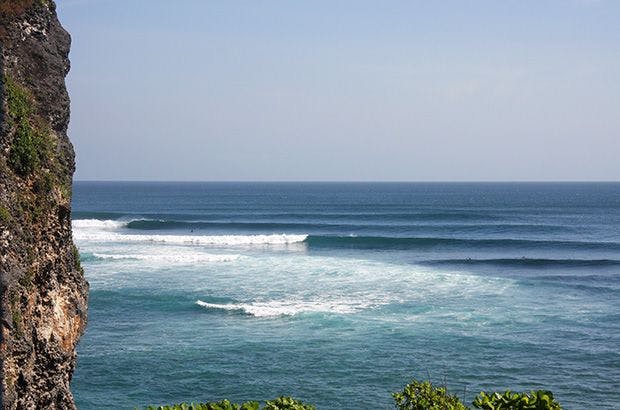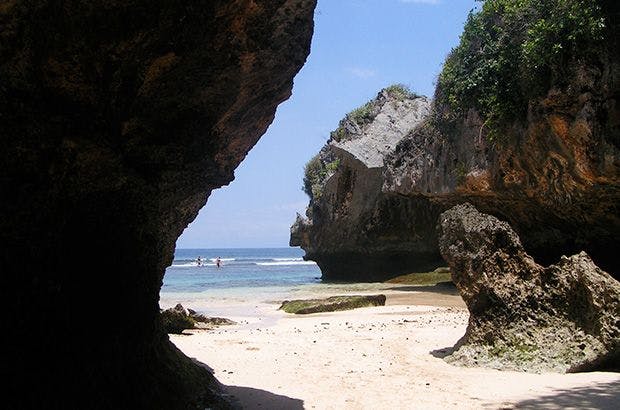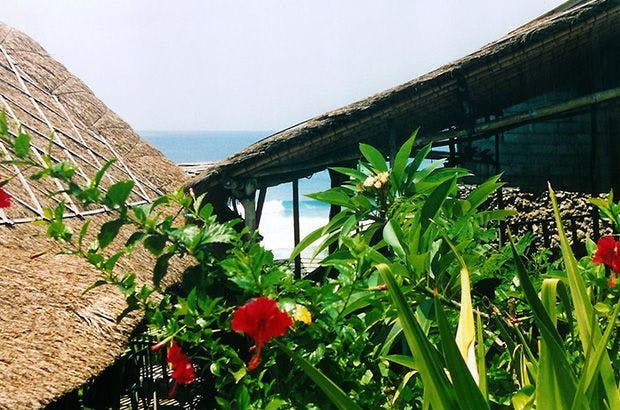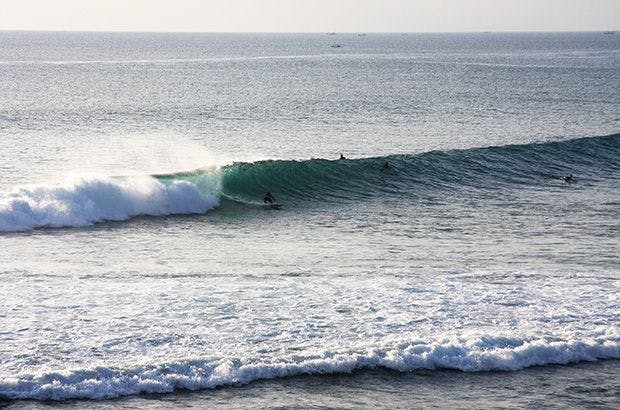TravelDeparture Gate: Bali’s Bukit Peninsula

The “Island of Gods”, as Bali is often referred to, is certainly blessed with the sort of perfect waves that have been drawing surfing pilgrims in large numbers for the past 45 years. A vast number of surfers aspire to one day surf the perfect lefts of Bali’s Bukit Peninsula, and judging by the number of surfers in the water at any of the island’s breaks on even the merest hint of a swell, many succeed in fulfilling that dream. There’s much more to Indonesia than Bali and more to Bali than the Bukit Peninsula, but with so many dream waves we have to start somewhere.

Image: Tom Corfield
Like a droplet of water falling from the tip of a leaf, the Bukit Peninsula hangs off the southern tip of Bali, the westernmost of Indonesia’s Lesser Sunda Islands that sits between the islands of Java and Lombok. The channels on either side of Bali, the Bali Strait and Lombok Strait are incredibly deep (the Lombok Strait marks the boundary between two major biomes, the Indomalayan ecozone and the Australasian ecozone) and they focus swells onto the Bukit Peninsula. These swells are generated almost year round in the roaring forties of the Southern Indian Ocean and by the time they have travelled unimpeded across the Indian Ocean and wrapped around the tip of the Bukit onto the Peninsula’s reefs they are organised into clean, groomed sets that are met head on by the South East trade winds of the dry season.

Image: Ceri Pashley
The first of these reefs is the most famous – a name known to every surfer: Uluwatu. The left hand reef break at Ulu’s (as it is popularly known) was first introduced to the surfing world by Alby Falzon in his 1972 movie “Morning of the Earth” when he documented surfers Rusty Miller and Steve Cooney (who was just 15 years old when it was filmed in 1970) surfing the break for the first time. Ulu’s breaks at the base of imposing cliffs and can handle almost any swell, with three sections spread over an enormous expanse of reef that at least disperses the significant crowds. Temples is the furthest south (unless you count the intimidating Outside Corner which only starts breaking when it gets over 10-foot) and can hold some serious size, however most surfers stick to The Peak (a.k.a. Inside Corner) just in front of the cave and it’s neighbor Racetracks on small and medium sized swells. The wave often sections on smaller swells however as it gets bigger it can start to run right through and it is possible to backdoor barrel sections as you race down the reef. The sections and “easy-ins” along much of the wave mean that, although Ulu’s is often the first and most frequent port of call for surfers on the Bukit, the crowd does spread along its length. The cave at Uluwatu is almost as famous as the wave and is the only way to access the water, however on the way back in from a surf (particularly on a high tide and big swell) aiming for the cave is a nerve-wracking experience with the consequences of missing it being either another long paddle circuit around for a second shot or being swept a mile or so along the coast to come in at Padang Padang.

Image: Ceri Pashley
Rare but beautiful, Padang Padang is the wave when it is on; a perfect barreling lefthander that breaks fast and hard, and increases in intensity as it runs down the reef and runs out of water. When Padang Padang is breaking it is big news and as a consequence the small take-off zone is packed with the best local, ex-pat and visiting surfers on the island. Expect heavy vibes, lapses in etiquette and some incredible barrels.
Heading northeast up the west coast of the peninsula, back in the direction of Kuta, the next surf spot is Impossibles. The name says it all, as Impossibles has three sections that are fast and separated by straight sections of reef that make every wave un-makeable at some point or another. That fact does reduce the crowds, however, so on an overhead swell and a mid to high tide it can prove a good option.
Bingin, another barreling left, is a very short wave breaking over an incredibly shallow reef. It’s possible to backdoor the take-off but once you’re in it’s very nearly time to kick out, and getting in requires waiting in line to get a spot at the take-off spot that is best described as “two’s company, whilst three’s a crowd”. But Bingin is worth the wait as it breaks consistently and mechanically, offering almost guaranteed tube time.

Image: Mat Arney
Between Bingin and Balangan is a sprawling tourist development, in the midst of which you’ll find Dreamland. Waves break at low tide over a fairly deep and flat reef, making it a friendly spot for most-comers. The beach is a hotspot for visiting tourists however the wave pales in comparison to its neighbours. Finally, before heading off the peninsula and back to the Kuta craziness, is Balangan. The last of the Bukit lefthanders, Balangan was almost lost to make way for a marina development in the early 90s. Best on a bigger swell when it breaks in front of an undercut headland it can offer a few hundred meters of speed walls and barrel sections. It also breaks on smaller swells when it offers more peaks although it can section and close-out unless swell size, direction, and tide heights are just right.

Image: Ceri Pashley
In the last 45 years Indonesia has developed as the dream destination for most surfers, in no small way thanks to the incredible lefts of Bali. As Australia’s closest Asian neighbor it is easily accessible to the enormous numbers of Aussie surfers who use Bali as their jumping-off point for a trip across the archipelago, as well as being well worth the long haul travel for surfers from the rest of the world. As a result Bali’s surf spots are crowded and, of greater concern, the infrastructure to accommodate the high numbers of visitors (both surfers and general tourists) has developed rapidly and not necessarily adequately. Litter and pollution are unfortunately an increasing issue around Bali. Unlike the dream-like perfection seen in Morning of the Earth, Bali and it’s Bukit Peninsula are these days crowded and have been the victim of unchecked development; but the waves are just the same and if you can get even just one good one then it’ll be well worth it.
WHERE: Denpasar (DPS)
WHEN: Dry season (May-Oct) for the lefts of the Bukit.
WHY: Iconic tropical left hand barrels.
HOW: Beefed up shortboard and a step-up or mid-range gun. A big gun if you’re game for taking on Outside Corner.